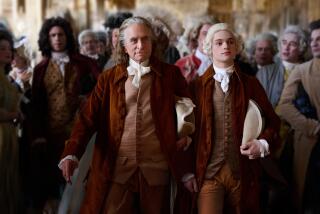Book review: ‘Franklin and Eleanor’ by Hazel Rowley
- Share via
The relationship of Eleanor and Franklin Delano Roosevelt has fascinated observers ever since they married. Friends and relatives were surprised in 1905 by the wedding of a handsome, flirtatious, fun-loving mama’s boy to his serious-minded cousin, who did not share his zest for outdoor recreation or cocktails and was no great beauty either. Their affinities were more obvious during Franklin’s political career, particularly his 12-year tenure in the White House, when Eleanor became the nation’s most activist and controversial but ultimately beloved first lady. Yet even then, with Eleanor famous for relentlessly intruding on her husband’s moments of relaxation to press him about thorny political matters, it was often difficult to understand the bond between such different people. After Eleanor’s death in 1962, as revelations came to light about his extramarital romances and her intimate friendships with several younger men and at least one woman, it became clear that the Roosevelt marriage was even more unconventional than contemporaries had realized. The mystery of why it worked remained.
British biographer Hazel Rowley aims to elucidate that mystery. She rejects what she calls “the standard narrative [of] Franklin and Eleanor keeping up a gracious façade, all the while finding their escape in politics and close friends.” Rowley, by contrast, sees their marriage as a “bold and radical partnership,” founded on deep love and acceptance that each had emotional needs better served by others. Those needs met, they could jointly devote themselves to the task of making America a fairer, more secure, more truly democratic nation.
The author’s ambition is commendable, her admiration for both Roosevelts evident. Her narrative, however, labors under substantial handicaps. As was the case with Rowley’s previous biography, “Tête-à-Tête: Simone de Beauvoir and Jean-Paul Sartre,” the vast majority of the material has been covered in many other books. As well as the numerous biographies of Franklin plus Blanche Wiesen Cook’s multivolume portrait of Eleanor, two works specifically address the Roosevelt marriage, Joseph Lash’s “Eleanor and Franklin” and Doris Kearns Goodwin’s “No Ordinary Time.” Goodwin in particular gives an exceedingly nuanced assessment of their relationship, which points to a larger problem for Rowley: Few of the various Roosevelt annalists offer the “absurdly conventional and condescending interpretation” she sets up as a straw man.
Rowley is hardly the first to discern that the couple’s mutual political commitment sustained their more problematic personal connection. Quibbles over whether they stopped having sex in 1916 after the birth of their sixth child, whether Franklin’s affair with Lucy Mercer was physically consummated or whether Eleanor really was “a reluctant first lady” ] do not constitute the kind of fresh insights needed to justify another reprise of well-known facts. From Sara Roosevelt’s role as the Mother-in-Law From Hell, through FDR’s crippling attack of polio and the revival of their marriage as a full political partnership, to the dying president’s election to an unprecedented fourth term, Eleanor colluding with doctors to cover up his terminal condition, Rowley basically retells a familiar story with more equal emphasis on both spouses.
In one area, however, the author does break new ground, though the reflections she prompts may not be the ones she intended. Time and again, she shows people such as FDR’s secretary Missy LeHand, his political advisor Louis Howe, Eleanor’s secretary Malvina “Tommy” Thompson and her intimate friend, reporter Lorena Hickok, lavishing on the Roosevelts an all-consuming devotion far beyond the bounds of ordinary professional or personal relationships. Hickcok gave up journalism to help Eleanor burnish her public image; Tommy, LeHand and Howe literally worked themselves to death “in the Roosevelt cause.” Rowley depicts the Roosevelt marriage as “a community” and celebrates their inclusion of these employees and friends within an extended family as “part of their generous spirit.” Another way of looking at it is that Eleanor and Franklin used people up, then moved on to others who could provide the support they required as they went about remaking America.
Rowley wouldn’t put it in those terms; they cast a shadow over her glowing portrait of “one of the most inspiring couples of all times.” This stock phrase does no justice to the sterner reality of the Roosevelts’ lives. Earlier appraisals of their marriage may have overly emphasized its negatives, but Rowley’s unduly minimizes infidelities, jealousy and exasperation on both sides. Franklin and Eleanor’s marriage was in many ways dysfunctional. It was also a triumph of shared purpose and dedication. If they expected those around them to sacrifice everything, they expected no less of themselves. They both believed it was his duty — and hers as well — to “do everything in his power to fulfill his promise to the people.” Theirs was in some sense a Faustian bargain, with private lives consumed on behalf of the public good, and Rowley would not diminish the Roosevelts’ achievements by more openly acknowledging their human cost.
Smith is the author of “Real Life Drama: The Group Theatre and America, 1931-1940.”
More to Read
The biggest entertainment stories
Get our big stories about Hollywood, film, television, music, arts, culture and more right in your inbox as soon as they publish.
You may occasionally receive promotional content from the Los Angeles Times.










